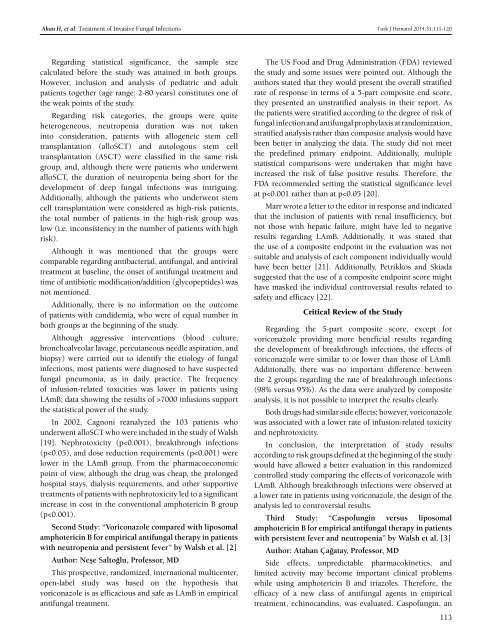Turkish Journal of Hematology Volume: 31 - Issue: 2
Create successful ePaper yourself
Turn your PDF publications into a flip-book with our unique Google optimized e-Paper software.
Akan H, et al: Treatment <strong>of</strong> Invasive Fungal Infections<br />
Turk J Hematol 2014;<strong>31</strong>:111-120<br />
Regarding statistical significance, the sample size<br />
calculated before the study was attained in both groups.<br />
However, inclusion and analysis <strong>of</strong> pediatric and adult<br />
patients together (age range: 2-80 years) constitutes one <strong>of</strong><br />
the weak points <strong>of</strong> the study.<br />
Regarding risk categories, the groups were quite<br />
heterogeneous, neutropenia duration was not taken<br />
into consideration, patients with allogeneic stem cell<br />
transplantation (alloSCT) and autologous stem cell<br />
transplantation (ASCT) were classified in the same risk<br />
group, and, although there were patients who underwent<br />
alloSCT, the duration <strong>of</strong> neutropenia being short for the<br />
development <strong>of</strong> deep fungal infections was intriguing.<br />
Additionally, although the patients who underwent stem<br />
cell transplantation were considered as high-risk patients,<br />
the total number <strong>of</strong> patients in the high-risk group was<br />
low (i.e. inconsistency in the number <strong>of</strong> patients with high<br />
risk).<br />
Although it was mentioned that the groups were<br />
comparable regarding antibacterial, antifungal, and antiviral<br />
treatment at baseline, the onset <strong>of</strong> antifungal treatment and<br />
time <strong>of</strong> antibiotic modification/addition (glycopeptides) was<br />
not mentioned.<br />
Additionally, there is no information on the outcome<br />
<strong>of</strong> patients with candidemia, who were <strong>of</strong> equal number in<br />
both groups at the beginning <strong>of</strong> the study.<br />
Although aggressive interventions (blood culture,<br />
bronchoalveolar lavage, percutaneous needle aspiration, and<br />
biopsy) were carried out to identify the etiology <strong>of</strong> fungal<br />
infections, most patients were diagnosed to have suspected<br />
fungal pneumonia, as in daily practice. The frequency<br />
<strong>of</strong> infusion-related toxicities was lower in patients using<br />
LAmB; data showing the results <strong>of</strong> >7000 infusions support<br />
the statistical power <strong>of</strong> the study.<br />
In 2002, Cagnoni reanalyzed the 103 patients who<br />
underwent alloSCT who were included in the study <strong>of</strong> Walsh<br />
[19]. Nephrotoxicity (p

















